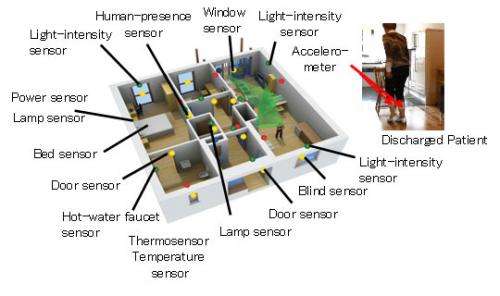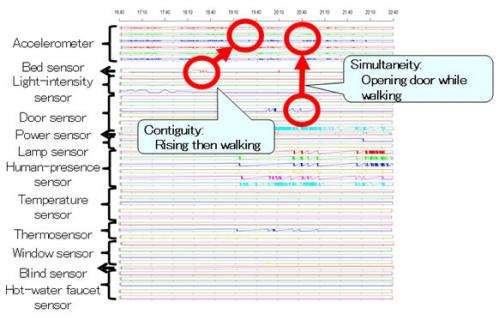Technology for early detection of irregularities in motor functions using a sensory smart house

Fujitsu announced it has developed a technology that uses sensors, embedded in smart houses and worn by patients, for the early detection of abnormalities in motor functions that might otherwise go unnoticed. Since July 2013 Fujitsu Laboratories, together with the Irish research institutions CASALA and Insight@UCD have implemented the KIDUKU Research Project, an initiative to provide health monitoring services and assisted independent living for senior citizens and patients who live in smart houses in Ireland. This project uses approximately 110 ambient sensors in a residence, along with body wearable sensors, to collect a vast array of data relating to a person's daily routine. In the past, there was no easy way to extract data related to signs of health decline and risks such as abnormal motor functions from vast amounts of data in a way that was meaningful to medical practitioners; it had also been difficult to make detections suited to individual circumstances.
From the results of the first year's research generated by this project, Fujitsu Laboratories and its partners have been able to develop technology to discover abnormalities that previously could have gone unnoticed by medical practitioners, by extracting "opened door" or "walked" that match an individual's way of walking from sensing data, and observing whether the events happen simultaneously or sequentially. It is now possible to identify a change in behavior that might indicate a decline in health, e.g. a patient who walks with a limp is prone to lose balance while walking and opening a door. Going forward, Fujitsu plans to continue testing this technology in other medical situations, applying and verifying it in places other than smart houses. In addition, it may be used in services that support independent living, such as providing personalized advice on potentially dangerous activities to patients and seniors living at home or in facilities.
Background
In July 2013, Fujitsu Laboratories, together with the Irish research institutions CASALA and Insight@UCD embarked on a three-year joint research project aimed at supporting people living full, independent lives with safety and peace of mind in the aging society. As part of the study, the KIDUKU Research Team is developing technologies to collect data from seniors and patients living in smart houses using wearable and ambient sensors, and to visualize and analyze that data. With the insights of clinical specialists who support independent living, the partners are working to develop a system that uses ICT to support health management and everyday life, with the goal of building solutions for seniors and patients using that system. A research project currently underway at a smart house in Ireland, using ICT to support independent living and health monitoring for residents, is collecting data on everyday life from some 110 sensors embedded in living spaces, as well as sensors worn by patients (Figure 1).
Issues
In the past, it has not been easy to extract data, from vast amounts of sensor data, connected to health risks, such as abnormal motor functions, that medical practitioners would find significant, and it has been difficult to make detections suited to individual circumstances. For example, as there are over 50 characteristics that can be extracted from walking data, such as stride length, stagger, and intensity, etc., and because these will vary from person to person, it is difficult to detect risks in everyday living such as poor mobility that might be caused by various disorders or illness.

About the Technology
Fujitsu Laboratories and its partners have developed a technology that extracts events such as "walked" (matched to each individual's gait) or "opened door" from the sensor data, and observing events that happen simultaneously or successively, it detects irregularities. For example, it will recognize that a patient who walks with a limp is prone to lose balance while walking and opening a door (Figure 2). Features of the technology include:
1. Detects events matched to individual circumstances and quantifies their characteristics.
Using environmental sensors, physical activity sensors, and vital-signs sensors, this technology continuously reports everyday activities, such as standing and walking ("body events"), and quantifies characteristics that will vary with each person and illness. For example, a sensor worn on the leg will determine that the wearer is walking if leg movements exceed a certain baseline value. In the case of someone with a very slow walking speed, that baseline value will need to drop. Conversely, for someone who walks at a normal speed, lowering that baseline value will result in misreads. To avoid this, the technology uses sensors embedded in the living space to identify actions and correlates these to the body events, to automatically optimize these baseline values. As a specific example of a baseline value, if sensors attached to doors detect transitions between open and closed twice in a given period of time, the system will treat that as the time of walking through the space between them, and will use that to set a baseline for detecting walking. Baseline values are determined by everyday activities as performed by the individual, so body events can be detected more accurately. The system can easily detect a patient walking, regardless of whether the patient has any leg problems, and it can also extract over 50 different gait characteristics, including stride length, stagger, and intensity, and can quantitatively compare changes in these characteristics in response to behaviors and health status.
2. Extracts previously unseen connections between events
Signs of motor function irregularity are known to show up when performing different actions in succession or simultaneously. For example, the action of opening a door requires that balance be maintained, and if it is difficult to keep one's footing, this may mean a potentially hidden problem. Likewise, the consecutive two-step process of rising from a chair and then walking can also reveal problems in the transition between actions. Based on these clinical insights, Fujitsu developed a technology that extracts patterns in the close relationships between body events such as the large volume of walking characteristics and ambient events such as opening doors. By repeatedly extracting the connections between body events (which may be related to a patient's illness,) and ambient events (which relate to the conditions in which they occur), it becomes possible to discover aspects of motor function irregularity that clinical practitioners may overlook. For example, in the case of someone who has trouble walking after getting out of bed, this technology would observe and provide insight to problems such as joint stiffness or changes in blood pressure after rising that a clinical practitioner could identify and start to question.
Results
This technology can illuminate previously undetected problems that will vary from person to person by quantifying everyday activities. For example, a patient who walks with a limp may be prone to loss of balance while walking after getting out of from bed. In this way, the technology detects risks hidden in everyday activities that will vary from person to person.
Fujitsu is aiming for a practical implementation of this technology in 2017, and is proceeding with a trial project in Ireland to test other disorders and to apply the technology and test it outside of smart houses, such as at people's existing homes. In the future, Fujitsu aims to develop services that can be used in the home or in institutions to identify behaviors that lead to an individual's risk and to provide operational support to medical practitioners.
Provided by Fujitsu





















